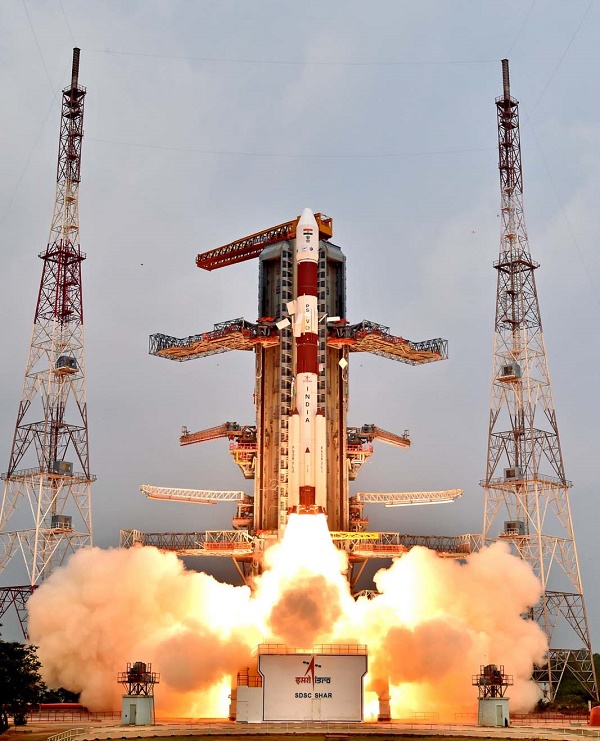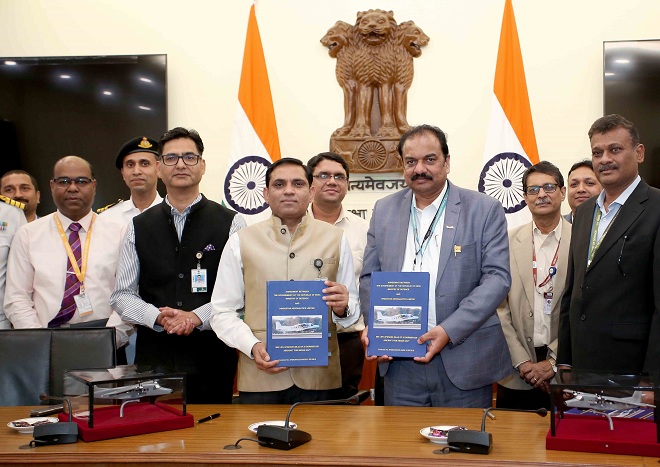
ISRO successfully launched India's fifth navigation satellite, the IRNSS-1E, in space. Photo: ISRO.
SRIHARIKOTA, AP (PTI): India on Wednesday successfully launched its fifth navigation satellite IRNSS-1E on-board the workhorse PSLV-C31 here, taking another step to join a group of nations equipped with their own satellite navigation systems like the US-based Global Positioning System (GPS).
In a precise textbook launch, the Polar Satellite Launch Vehicle (PSLV) C 31 blasted off from the Satish Dhawan Space Centre (SDSC) here, about 110 km from Chennai at 9.31 AM and released the satellite into the orbit 19 minutes and 20 seconds later.
President Pranab Mukherjee congratulated the ISRO team on the launch.
"Heartiest congratulations to ISRO team on the successful launch," he said.
Lauding the "dynamism and determination" of ISRO scientists, Prime Minister Narendra Modi said they have made the country proud.
"Congratulating the dynamism & determination of @isro & our scientists on successful launch of PSLV C31 & putting IRNSS-1E in orbit precisely", he said on twitter.
"Spoke to the scientists at @isro & congratulated them on their accomplishment. Our scientists keep making us proud", Modi said.
IRNSS-1E is the fifth navigation satellite in the IRNSS space system, comprising seven satellites, which would be on par with US-based GPS once the full complement of spacecraft is launched.
As the rocket soared into the clear blue sky at the end of the 48 hour countdown, all the four stages of PSLV executed their functions as programmed, to the joy of ISRO scientists at the mission control centre.
After the satellite's injection into geo synchronous transfer orbit (GTO), the two solar panels of IRNSS-1E will be automatically deployed in quick succession.
The Master Control Facility in Hassan (Karnataka) would then take control of the satellite to perform orbit raising operations.
Though the earlier four satellites would be sufficient to start operations of the IRNSS system, the remaining three would make it more "accurate and efficient".
Congratulating the ISRO team for the success of the launch, a beaming ISRO Chairman A S Kiran Kumar said, "Today with this new year we are starting the Indian Regional Navigation Satellite fifth launch, fifth of the seven satellite constellation. With this satellite in place, within our country we will be able to get 24/7 provisional a good positional accuracy".
On the future launches, Kiran Kumar said, "We have a long way to go. This year we are planning to launch the earth observation satellites."
"Let me congratulate the entire ISRO team for the work they have done and we are having a long way to go. We have got two more satellites to be launched in this constellation, which would happen in next couple of months", he said from the Mission Control Centre.
He said the ISRO scientists intended to complete this year the launch of GSLV-Mark III which will carry heavier satellites into geo-stationery transfer orbits.
"And, we have a long way to go. And I would like to remind all my colleagues, while we have started the new year with success, we need to dedicate ourselves for completing the task on hand", he said.
Mission Director B Jayakumar said, "ISRO starts the New Year with a grand success. IRNSS-1E has been injected very precisely into the intended orbit. We have employed the most powerful vehicle for this launch with that able to carry the satellites. We have three variants in PSLV and with this launch we have completed 33 launches in PSLV."
"With this, the uniqueness is 11,11,11. The core alone version 11xL variant is 11 and generic variant is 11. It is first Mission for ISRO in new year", Jayakumar said.
IRNSS-1E has configuration similar to its predecessors IRNSS-1A, 1B, 1C and 1D and carries two types of payloads -- navigation and ranging payloads.
The navigation payload will transmit navigation service signals to the users and operating in L5-band and S-band, while the other comprises a C-band transponder that facilitates accurate determination of the satellite range.
IRNSS-1E has a lift-off mass of 1,425 kg and carries Corner Cube Retro Reflectors for laser ranging and a highly accurate rubidium atomic clock (also part of the navigation payload of the satellite).
The four satellites already launched include IRNSS-1A on July 1, 2013, IRNSS-1B on April 4, 2014, IRNSS-1C on October 16, 2014, IRNSS-1D on March 28, 2015.
ISRO scientists plan to put all the seven navigation satellites in to the orbit by March 2016.
The mission life of IRNSS-1E is 12 years.
 Previous Article
Previous Article Next Article
Next Article














The Indian Air Force, in its flight trials evaluation report submitted before the Defence Ministry l..
view articleAn insight into the Medium Multi-Role Combat Aircraft competition...
view articleSky enthusiasts can now spot the International Space Station (ISS) commanded by Indian-American astr..
view article